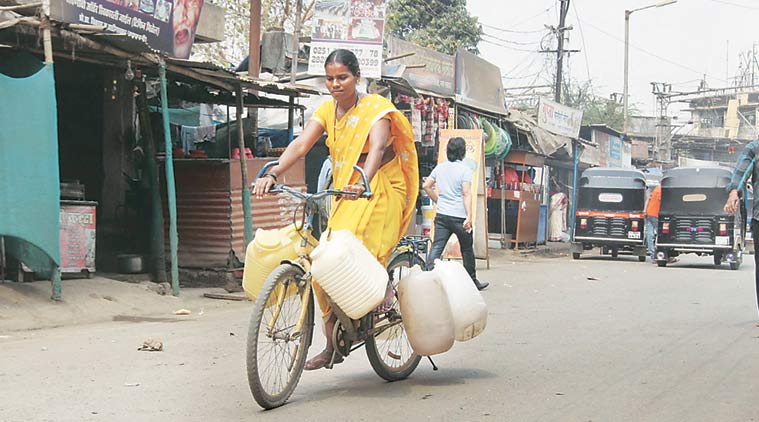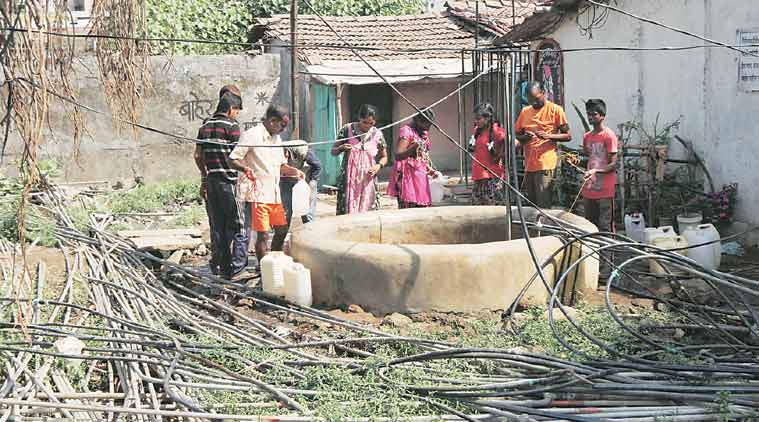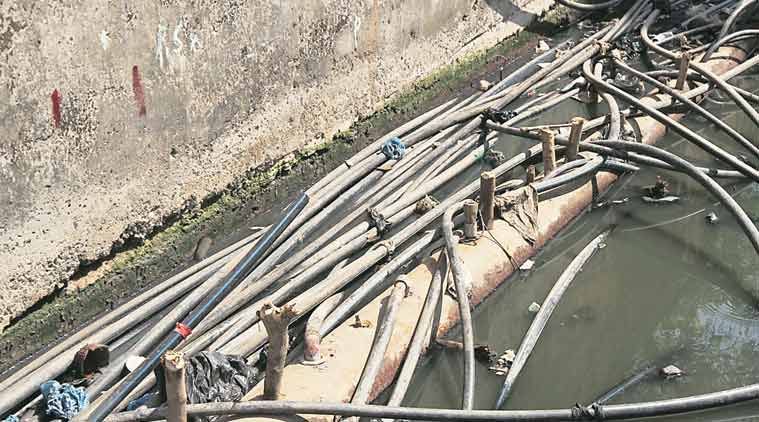Stay updated with the latest - Click here to follow us on Instagram
Waterless Mumbai’s outskirts– Why did I get married here: Frustration in a parched town
The town’s population has ballooned six times to 4.5 lakh in under five years, without the commensurate growth in infrastructure.
 This year’s urban water scarcity amid Maharashtra’s worst-ever drought has exacerbated the situation. (Express Photos by Deepak Joshi)
This year’s urban water scarcity amid Maharashtra’s worst-ever drought has exacerbated the situation. (Express Photos by Deepak Joshi)
There is an endless line of empty water cans dotting the roads at the only two places where the taps have not yet run dry in Diva, a township on the outskirts of Mumbai. One is a Shiva temple near the Diva railway station. The other is a local politician’s office, which has inexplicably become an oasis amid a large cluster of buildings where taps gurgle to life only once every three or four days.
The burgeoning township, just 22 kilometres from the farthest point of the financial capital, has for years battled water scarcity due to shoddy planning, illegal constructions and continuing municipal neglect. But this year’s urban water scarcity amid Maharashtra’s worst-ever drought has exacerbated the situation, and for Diva’s homemakers now, life is a constant, tiresome pursuit of water.
At about 2 pm, when the two taps start squirting water, nearly all the housewives in the township wrap up household chores and rush to await their turn. Water gushes till 10 pm, four days of the week.
It is a daily test. If they have managed to queue up their water cans the previous night or in the wee hours of the morning, they will be able to bring home one can of drinking water by evening. If they were slightly late in queuing up, they may have to sit guarding their water cans till 9 pm or 10 pm, awaiting their turn.
“I got a little late today,” says 43-year-old Anuja Gawde, fanning herself with the loose end of her saree pallu outside the Shiva temple. “My son was not well. I could get here only after 6 am. Now it looks like it’s going to be a long wait, and all this for just one can,” Gawde says, as she wearily eyes the line of water cans. It is 3.30 pm, and Gawde’s can is 120th in queue. “In Diva, every day is bad, but this year is a different ordeal altogether…” She stops mid-sentence, fiercely rushing to the queue and joining a squabble with another woman trying to break the can-queue.
 Across municipalities in this region just outside Mumbai, including the Thane Municipal Corporation, the Kalyan-Dombivali Municipal Corporation, the Navi Mumbai Municipal Corporation and a handful of smaller municipal councils, tackling the water shortage has quickly turned into a challenge of unprecedented scale. The Thane Municipal Corporation, which operated a few 60-hour water cuts in areas such as Mumbra, Kalwa, Diva and 40-hour water cuts elsewhere in Thane, is trying to find alternative sources of water. The 480 million litres per day sourced from the Bhatsa and Barvi dams is now down to 320 MLD — 160 MLD short. The TMC has resorted to digging borewells and handpumps alongside cleaning old wells.
Across municipalities in this region just outside Mumbai, including the Thane Municipal Corporation, the Kalyan-Dombivali Municipal Corporation, the Navi Mumbai Municipal Corporation and a handful of smaller municipal councils, tackling the water shortage has quickly turned into a challenge of unprecedented scale. The Thane Municipal Corporation, which operated a few 60-hour water cuts in areas such as Mumbra, Kalwa, Diva and 40-hour water cuts elsewhere in Thane, is trying to find alternative sources of water. The 480 million litres per day sourced from the Bhatsa and Barvi dams is now down to 320 MLD — 160 MLD short. The TMC has resorted to digging borewells and handpumps alongside cleaning old wells.
Thirty-eight-year-old Lalita Suryavanshi, also waiting in the sun at Diva’s Shiva temple, says, “We wake up for water. The day starts at 4 am, with a mad rush to line up our water cans at the temple. Then we set deadlines to complete our chores, cooking, packing tiffins, washing, cleaning, scrubbing, all in order to get back to the temple by 2 pm for water. From there on, we have no idea how long it will take for our turn. If we are lucky, we are home with a can of water by 6 pm-7 pm, but if we are late in the morning…We don’t want to be late in the morning.”
 The town’s population has ballooned six times to 4.5 lakh in under five years, without the commensurate growth in infrastructure.
The town’s population has ballooned six times to 4.5 lakh in under five years, without the commensurate growth in infrastructure.
Diva, part of the bustling Mumbai Metropolitan Region, usually gets 18.5 MLD a day, before the 40 per cent water cut. Most of the water, however, does not reach Diva’s households due to a weak distribution network and the fact that 90 per cent of the buildings here are illegal. Water theft and leakages add to the mix.
The town’s population has ballooned six times to 4.5 lakh in under five years, without the commensurate growth in infrastructure. Residents, most from the economically weaker strata, rely on water tankers, and taps have remained dry for years. Some luckier households get supply, unannounced, for an hour every three-four days. The Indian Express reported last year that Diva’s women conduct a daily evening ritual of boarding a crowded local train to Mumbra, 4 kilometres away, to bring home water from a tap in the neighbouring township.
“We still travel to Mumbra, but the situation there is also bleak. We get water in Mumbra only twice a week now, on Wednesdays and Saturdays,” says 29-year-old Asmita Sawant, who shifted to Diva from Mumbai five years ago upon getting married. This Wednesday, like others, Sawant hurried home early from work in Thane to get two cans of water from Mumbra, some respite for the next couple of days. “I used to live in Mumbai with no water problems at all, ever,” she says. “These days, I think a lot about why I even agreed to get married in the first place.”
Eighteen-year-old Archana Gaikwad, who also moved to Diva from Mumbai after getting married last year, says she budgets water and also sets aside Rs 3,000 a month to buy water from tankers for washing, cleaning, cooking, bathing, flushing.
An engineer from the Shiv Sena-BJP-controlled Thane Municipal Corporation, under whose jurisdiction Diva falls, said, “Last year, we laid a new six-inch water pipeline near Nagwadi, one of the worst-affected areas, and put a concrete casing on one main water line, which locals used to otherwise puncture to draw water to their homes. We have now approved two more proposals, one worth Rs 49 lakh to lay a new water line from Diva talao to the station, and another worth Rs 30 lakh to replace an old water line. But, truthfully, the situation is irreparable.”
Back in the queue, 48-year-old Uma Shahu gets a call. It’s a friend from Mumbai, wondering when she can visit to meet Uma’s one-month-old granddaughter. She makes up an excuse hurriedly and excuses herself from the prospective visit. “What do I do?” she says. “There is no time for guests in between running around for water. And besides I don’t have drinking water to spare for guests.”







